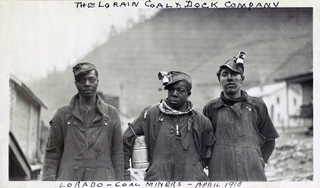 | Back to e-WV
| Back to e-WV
 The West Virginia Encyclopedia
The West Virginia Encyclopedia
 | Back to e-WV
| Back to e-WV
 The West Virginia Encyclopedia
The West Virginia Encyclopedia

African-Americans played a key role in the growth of West Virginia’s coal industry. Blacks from rural areas of the upper south, mainly Virginia, helped to lay track for the three major railroads that opened up the bituminous fields: the Chesapeake & Ohio, the Norfolk & Western, and the Virginian. It was work on the C&O, at the Great Bend Tunnel in Summers County, that produced the Black folk hero John Henry.
As each railroad completed lines through the region, contingents of Black railroad men remained behind to work in the coal mines. They were later joined by growing numbers of Blacks who went directly into the mines. While Blacks from the nearby states of Virginia, Kentucky, and Tennessee dominated the migration to West Virginia during the early period, the advent of World War I brought growing numbers of migrants from the Deep South states of Alabama, Georgia, and Mississippi.
From the turn of the century through the early 1930s, African-Americans made up between 20 percent and 26 percent of the total coal mining labor force in southern West Virginia. They also gradually increased their numbers in the mines in northern West Virginia, but they would remain a much smaller percentage of the total there. Coal companies actively recruited Black workers, but Black men and women also established their own kin and friendship networks, and helped to facilitate their own movement into the coal towns.
During the Great Depression of the 1930s, Blacks shouldered a disproportionate share of the unemployment and hard times. Their percentage in the state’s coal mining labor force dropped from more than 22 percent in 1930 to about 17 percent in 1940. The Depression and World War II also unleashed new technological and social forces that transformed the coal industry, and stimulated massive out-migration in the postwar years. Loading machines rapidly displaced miners during the 1940s and ’50s. Black miners recall that the mine management always put the first loading machines where Blacks were working, meaning that Black miners were the first to lose their jobs.
As the state’s Black coal mining labor force declined, racial discrimination persisted in all facets of life. In 1961, according to the West Virginia Human Rights Commission, most of the state’s public accommodations—restaurants, motels, hotels, swimming pools, and medical facilities—discriminated against Blacks. By the late 20th century African-American miners had dropped to less than three percent of the work force, and as Blacks lost coal mining jobs, they found few alternative employment opportunities. Today, Black miners comprise less than five percent of the mine workforce nationally.
Written by Joe William Trotter Jr.
Corbin, David A. Life, Work, and Rebellion in the Coal Fields: The Southern West Virginia Miners 1880-1922. Urbana: University of Illinois Press, 1981.
Lewis, Ronald L. Black Coal Miners in America. Lexington: University Press of Kentucky, 1987.
Salzman, Jack, et al., eds. Encyclopedia of African American Culture and History. New York: Macmillan, 1996.
Trotter, Joe William Jr. Coal, Class, and Color: Blacks in Southern West Virginia, 1915-32. Urbana: University of Illinois Press, 1990.